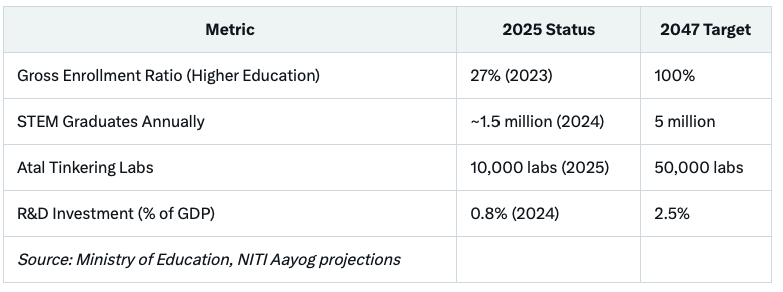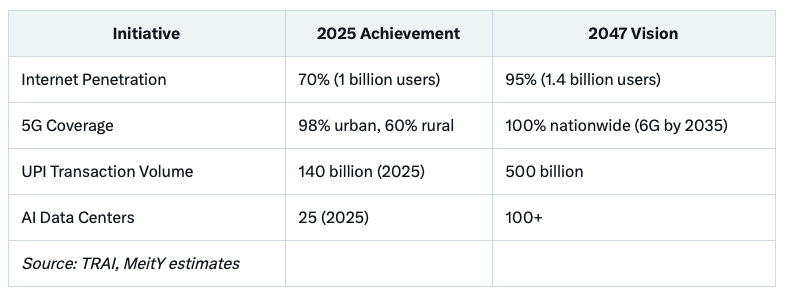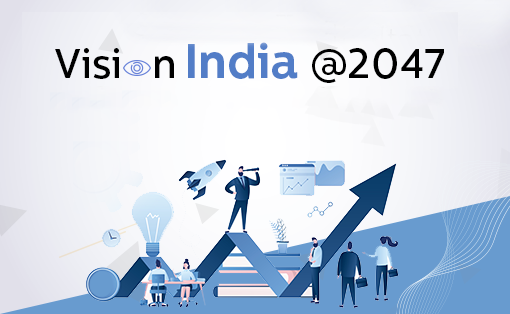As India celebrates its 79th Independence Day on August 15, 2025, the nation stands at a pivotal moment in its journey as a global leader in innovation. By 2047, when India marks its centennial year of independence, the vision is to transform into a Viksit Bharat — a developed, inclusive, and technologically advanced nation that leads the world in innovation. This vision, articulated through the Viksit Bharat@2047 initiative, is not just about economic growth but about harnessing technology, human potential, and global collaboration to solve pressing challenges in healthcare, education, sustainability, and beyond. India’s roadmap to 2047 is built on strategic investments in education, research and development (R&D), digital infrastructure, and ethical innovation, positioning the country as a global beacon of progress.
Building a Knowledge Economy Through Education
The foundation of India’s innovation future lies in its education system, which is undergoing a transformative overhaul to prepare a generation for a technology-driven world. The National Education Policy (NEP) 2020, which marked its fifth anniversary in July 2025, has set a bold blueprint for this transformation. By emphasising critical thinking, interdisciplinary learning, and STEM (Science, Technology, Engineering, and Mathematics) education, NEP 2020 is reshaping how India nurtures its talent. With over 50 per cent of India’s 1.4 billion population under 35 in 2025, India remains one of the youngest nations globally, poised to leverage this demographic dividend for innovation. Initiatives like the Atal Tinkering Labs (ATLs), established under the Atal Innovation Mission, have engaged over 10 million students in hands-on innovation since 2016, fostering creativity through robotics, coding, and prototyping. By 2047, India aims to achieve 100% gross enrollment in higher education, a significant leap from 27% in 2023, according to the Ministry of Education.
The NEP’s fifth anniversary in 2025 highlights its impact: Over 2,000 higher education institutions have adopted multidisciplinary curricula, and vocational training has reached 15 million students annually. Programmes like the PM SHRI Schools and Samagra Shiksha are extending quality education to rural areas, ensuring inclusivity. The focus on regional languages and digital learning platforms, such as DIKSHA, has made education accessible to diverse communities, empowering first-generation learners. By 2047, India envisions a knowledge economy where every citizen, from metropolitan hubs to remote villages, contributes to innovation.
Table 1: India’s Education and Innovation Goals (2025–2047)

Scaling Research and Development for Global Impact
India’s ambition to lead in innovation hinges on robust investment in Research and Development (R&D). In 2024, India’s R&D expenditure was approximately 0.8% of GDP, significantly lower than global leaders, including the US (3.5%) and China (2.4%). The Anusandhan National Research Foundation (ANRF), launched in 2024 with a ₹50,000 crore budget, aims to bridge this gap by fostering public-private partnerships. By 2047, India targets increasing R&D spending to 2.5% of GDP, focusing on AI, quantum computing, biotechnology, and space technology. Institutions such as IITs and the Indian Institute of Science (IISc) are already global hubs for cutting-edge research, with IIT Madras contributing to India’s first quantum communication trial in 2024.
Digital Infrastructure: The Backbone of Innovation
India’s digital revolution, driven by initiatives like Digital India, has laid a strong foundation for future innovation. The BharatNet project has connected nearly 200,000 villages to high-speed internet, and the 5G rollout covers 98% of urban areas. Looking to 2047, India aims to pioneer 6G technology, with research underway at IIT Chennai and industry partnerships with Nokia and Ericsson. The Unified Payments Interface (UPI) is handling over 140 billion transactions annually, evolving into a global fintech standard, with countries such as Singapore and the UAE adopting UPI-based systems.
Table 2: Digital Infrastructure Milestones (2025–2047)
 Sustainable Innovation for a Greener Future
Sustainable Innovation for a Greener Future
India’s commitment to sustainability is central to its 2047 Vision. As the third-largest producer of renewable energy, India aims to achieve 500 GW of non-fossil energy by 2030 and net-zero emissions by 2070. Innovations in green hydrogen, led by companies such as Reliance and Adani, position India as a potential global supplier. The National Green Hydrogen Mission, with a ₹19,744 crore budget, targets 5 million tonnes of annual production by 2030. Electric vehicle (EV) adoption is also surging, with over 2 million EVs running on Indian roads by 2025 end, supported by 50,000 charging stations.
Global Collaboration and Leadership
India’s innovation future is deeply tied to its global role. As a G20 leader and co-founder of the International Solar Alliance, India is shaping international tech and climate agendas. By 2047, India aims to lead in ethical AI governance, with frameworks like the India AI Mission, emphasising responsible AI. Partnerships with the US (through the iCET initiative), the EU, and Japan are fostering technology transfers in semiconductors, space, and quantum computing. Indian startups are also going global, with 20% of India’s 100+ unicorns operating internationally by the end of 2025.
Empowering the Next Generation of Innovators
India’s youth are the torchbearers of its 2047 Vision. Programmes like Skill India aim to train 400 million workers by 2030, focusing on AI, robotics, and green tech skills. Women in STEM are also a priority, with initiatives like the Women Entrepreneurship Platform supporting 10,000 women-led startups by 2025. Grassroots innovation is thriving, with rural innovators developing low-cost solutions, such as solar-powered irrigation systems and affordable prosthetics.
Challenges and the Path Forward
India’s trajectory towards becoming a global innovation leader by 2047 is promising, but significant challenges must be addressed to realise the Viksit Bharat@2047 vision. These hurdles — brain drain, regulatory bottlenecks, infrastructure gaps in Tier-2 and Tier-3 cities, and ethical concerns around AI and data privacy — require strategic interventions to ensure an inclusive, sustainable, and competitive innovation ecosystem. By tackling these issues head-on, India can transform challenges into opportunities, paving the way for a future where innovation empowers every citizen.
Brain Drain: Retaining Talent
The migration of skilled professionals, known as ‘brain drain’, remains a critical challenge. In 2024, approximately 1 million Indian professionals, including engineers, doctors, and researchers, left for opportunities abroad, primarily in the US, Canada, and the UK, according to the Ministry of External Affairs. This loss of talent hampers India’s innovation potential. To reverse this trend, India must offer competitive opportunities, such as higher salaries, world-class research facilities, and startup incentives. Initiatives like the PM’s Research Fellowship and Global INK Fellowships have attracted 5,000 researchers back to India since 2020, but scaling such programmes is essential. Tax benefits for returning professionals and collaborations with global tech hubs can further incentivise talent retention.
Regulatory Bottlenecks: Streamlining Innovation
Complex regulations and bureaucratic delays stifle innovation, particularly for startups in various emerging sectors such as AI, biotech, and drones. In 2025, it takes an average of 90 days to secure licenses for tech startups in India, compared to 30 days in Singapore, per a NASSCOM report. The Ease of Doing Business reforms improved India’s ranking to 50th globally in 2024, but further simplification is needed. Single-window clearance systems and sector-specific regulatory sandboxes, like those for fintech, can accelerate growth. By 2047, India aims to reduce compliance time to under 30 days, fostering a startup-friendly environment.
Infrastructure Gaps: Empowering Tier-2 and Tier-3 Cities
Innovation is concentrated in metropolitan hubs such as Bengaluru and Hyderabad, leaving Tier-2 and Tier-3 cities underserved. In 2025, only 20% of India’s 10,000 Atal Tinkering Labs are in non-metro areas, limiting grassroots innovation. The Smart Cities Mission and BharatNet have improved connectivity, but power outages and inadequate R&D facilities persist in smaller cities. Investments in tech parks, incubators, and 5G infrastructure in cities such as Bhubaneswar and Indore are critical to decentralising innovation by 2047.
Ethical AI and Data Privacy: Building Trust
As India advances in AI, ethical concerns and data privacy challenges loom large. The India AI Mission promotes responsible AI, but incidents like data breaches, which affected 500 million users in 2024, highlight vulnerabilities. The Personal Data Protection Act (PDPA), 2023, is a step forward, but enforcement remains weak. By 2047, India envisions a robust AI governance framework with global standards, like the EU’s AI Act, to ensure transparency, fairness, and user trust.
Conclusion
A Vision for 2047: By 2047, India aims to be a $30 trillion economy, driven by innovation that touches every citizen’s life. From AI-powered healthcare diagnostics in remote villages to space missions exploring Mars, India’s aspirations are boundless. The Viksit Bharat@2047 vision is about creating a nation where technology empowers, unites, and inspires. As we celebrate Independence Day 2025, let us commit to this future — a future where India not only innovates for itself but leads the world towards a better tomorrow.








